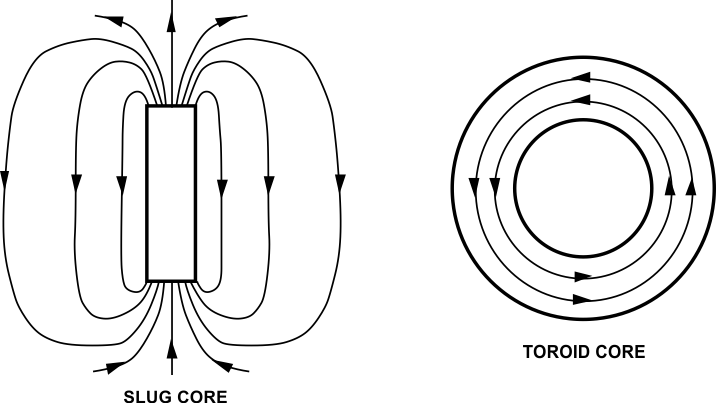SNVA559C September 2012 – February 2019 LM2574 , LM2575-N , LM2575HV , LM2576 , LM2576HV , LM2577
-
Switching regulator fundamentals
- Trademarks
- 1 Switching Fundamentals
- 2 Switching Converter Topologies
- 3 Application Hints for Switching Regulators
- 4 Application Circuits
- 5 References and Related Products
- Revision History
3.3 Transformer/Inductor Cores and Radiated Noise
The type of core used in an inductor or transformer directly affects its cost, size, and radiated noise characteristics. Electrical noise radiated by a transformer is extremely important, as it may require shielding to prevent erratic operation of sensitive circuits located near the switching regulator.
The most commonly used core types will be presented, listing the advantages and disadvantages of each.
The important consideration in evaluating the electrical noise that an inductor or transformer is likely to generate is the magnetic flux path. In Figure 19, the slug core and toroidal core types are compared.
 Figure 19. Flux Paths in Slug and Toroid Cores
Figure 19. Flux Paths in Slug and Toroid Cores The flux in the slug core leaves one end, travels through the air, and returns to the other end. The slug core is the highest (worst) for radiated flux noise. In most cases, the slug core device will give the smallest, cheapest component for a given inductor size (it is very cheap to manufacture).
The magnetic flux path in the toroid is completely contained within the core. For this reason it has the lowest (best) radiated flux noise. Toroid core components are typically larger and more expensive compared to other core types. Winding a toroid is fairly difficult (and requires special equipment), driving up the finished cost of the manufactured transformer.
There is another class of cores commonly used in magnetic design which have radiated flux properties that are much better than the slug core, but not as good as the toroid.
These cores are two-piece assemblies, and are assembled by gluing the core pieces together around the bobbin that holds the winding(s). The cores shown are frequently gapped to prevent saturation of the Ferrite core material. The air gap is installed by grinding away a small amount of the core (the gap may be only a few thousandths of an inch).
Figure 20 shows the popular E-I, E-E and Pot cores often used in switching regulator transformers. The cores show the locations where an air gap is placed (if required), but the bobbins and windings are omitted for clarity.
 Figure 20. Flux Paths in E-I, E-E and Pot Cores
Figure 20. Flux Paths in E-I, E-E and Pot Cores The air gap can emit flux noise because there is a high flux density in the vicinity of the gap, as the flux passing through the core has to jump the air gap to reach the other core piece.
The E-E and E-I cores are fairly cheap and easy to manufacture, and are very common in switching applications up to about 1 kW. There is a wide variety of sizes and shapes available, made from different Ferrite blends optimized for excellent switching performance. The radiated flux from this type of core is still reasonably low, and can usually be managed by good board layout.
The Pot core (which is difficult to accurately show in a single view drawing), benefits from the shielding effect of the core sides (which are not gapped). This tends to keep the radiated flux contained better than an E-E or E-I core, making the Pot core second best only to the toroid core in minimizing flux noise.
Pot cores are typically more expensive than E-E or E-I cores of comparable power rating, but they have the advantage of being less noisy. Pot core transformers are much easier to manufacture than toroid transformers because the windings are placed on a standard bobbin and then the core is assembled around it.